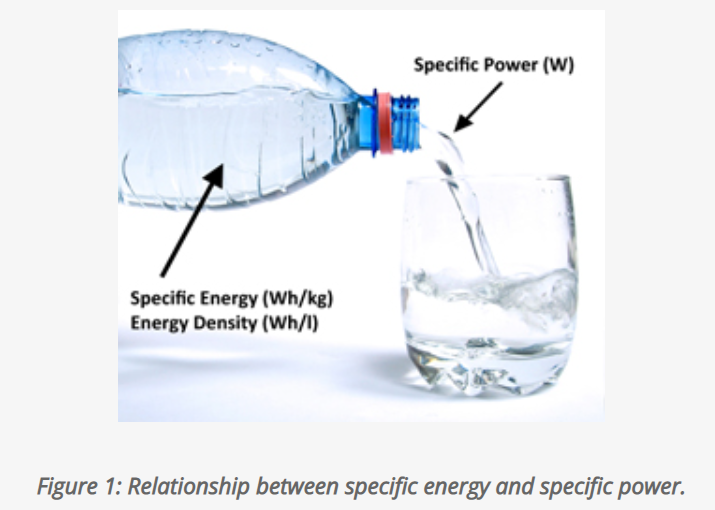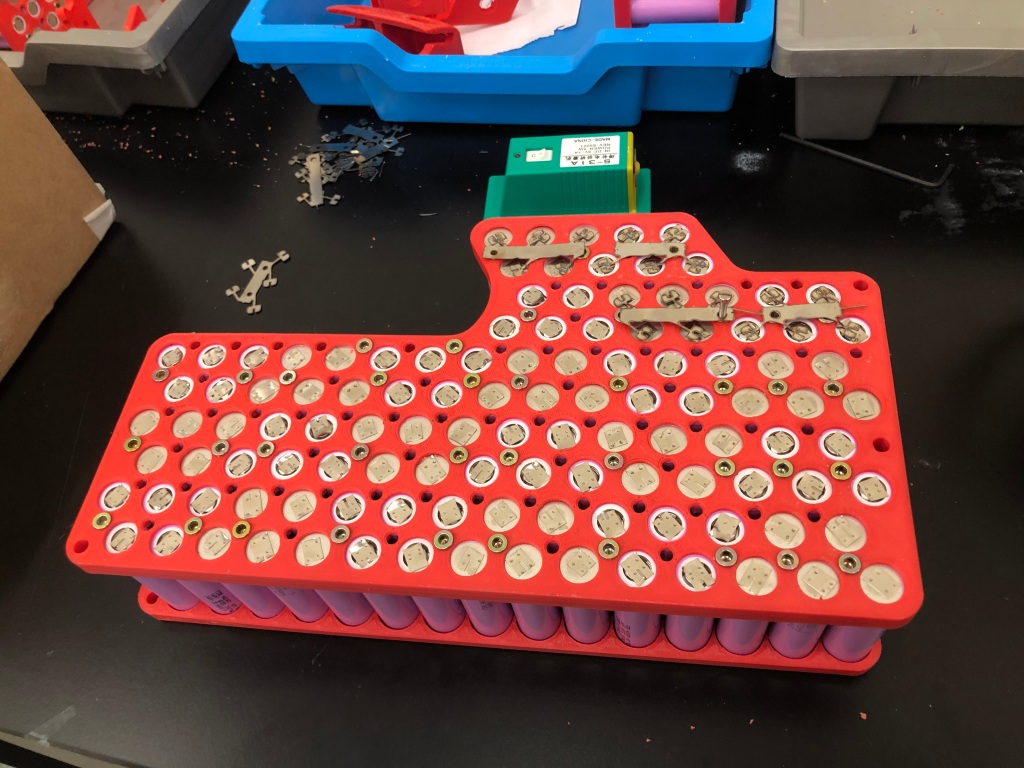In electric cars, the main source of energy is a battery instead of an engine. In this page I will explain how I designed the high voltage battery for our Formula SAE electric car. The process can be summarized into 4 steps: identify your battery’s required specifications, select the best cell for your vehicle’s requirements (there is no 1 perfect cell for every car), design the battery configuration with the cell you chose (which means the number of cells in series and parallel), and lastly figure out how you will connect your cells together.
Determining battery specifications
There are 3 specifications that determine the size of a battery: its voltage, maximum power and energy capacity.
Determining battery voltage
For FSAE 2022, the maximum allowed voltage our battery could have was 600V. Power = current x voltage, so for a fixed power that you want your battery to provide, you can either increase the current or the voltage of your battery to get the desired product value. Power lost as heat = current^2 x resistance, so the larger the current supplied by the battery, the more heat losses will arise across any resistive path such as wires, cell-to-cell connections, etc. We of course want to have an efficient system with minimal heat losses, so that is why we decided to go for a higher voltage to minimize the current our battery would supply to provide our desired power value (which I talk about in the next section). We set a target of 600V for our battery (later after performing the rest of the calculations we only ended up with 579V).
BUT if I could do this over again, I would limit our battery size to 500V for this reason: any component that would be connected to your battery such as wires, connectors and relays has to be rated for your battery’s maximum voltage. After going through with the design and actually building the battery I found that finding components rated for >500V was more difficult, the components were more bulky and more expensive. It seems like there is almost a category for components rated for less than 500V and another for those rated higher than 500V.
Your battery’s voltage has to be limited to the maximum rated voltage of your motor and motor controller (the purpose of the battery is to provide the motor/s with power to drive the car, so the motor and its controller have to be selected first). Our motor was the Emrax 228 and our motor controller was from Unitek, both of which were rated for above 600V, so our voltage was not constrained by those components.
Determining battery power and energy capacity
Batteryuniversity.com uses a nice analogy to explain the concept of power and energy through this picture

The energy of a battery is analogous to the amount of water stored in the bottle: the more water is in the bottle the longer it will last. Similarly, the more energy our car’s battery has the longer the car can drive for. This is important for the Formula SAE endurance race, in which the car has to complete a ~20km track.
The power of a battery is analogous to the opening of the water bottle, the bigger the opening, the more water can flow our per second, or the faster water can flow out. Similarly, the more power our car’s battery can provide, the faster the car can drive. This is important if you want to achieve a acceleration.
We chose to size our battery so that it can provide the maximum allowable power by Formula SAE rules, which is 80 kW. We decided on our energy requirement by approximating how long it would take our car to complete the endurance race (based on a lap time simulator and the average time taken by FSAE cars to complete the race), and multiplying that by the continuous power we estimated our motor would draw (energy = power x time for which that power will be drawn) . These calculations were performed by our Power Train team. We ended up with a target energy value of 7.6kWh.
Cell selection
Choosing a cell can be overwhelming because there are many different chemistries, packaging styles and models in the market. The criteria which we based our cell selection on were the following six: power and energy per unit mass, volume and dollar. We created a database comparing different models of cells in terms of these values which eventually helped us come up with the most optimized (mass, volume and cost efficient) design. For example, the higher the power per unit mass and volume for a cell, the less quantity of that cell you will need to meet your power target. There will be tradeoffs, however: cells are usually either energy optimized or power optimized (a cell will either have more energy and less power or vice versa), and the higher the specific power and energy, the smaller pack you can have, but the more expensive the cell will be.

After comparing many cells, we narrowed down the top five or so cells in terms of the criteria mentioned above. We made our final selection after comparing the different configurations we would need with each cell to meet our design requirements.
Battery configuration
A battery’s configuration refers to the number of cells connected in parallel and series, and in which order. For example, a 5p10s pack means that 5 cells are connected in parallel first then 10 groups of those are connected in series. The advantage of this sort of configuration is that when connecting the cells to a battery management system, only one wire would be needed per parallel group, since cells in parallel will have the same voltage across them. So, for this example, only 10 voltage sense connections will be needed (instead of 50 which would be needed if the configuration was 10s5p).
Here is how you calculate the number of cells your pack will need:
Maximum battery voltage [V] = maximum cell voltage [V] * # series connections
First, use the equation above to determine how many series cells are needed to meet your battery’s voltage target. The other two targets are energy and power capacity of the battery which are determined by the total number of cells in the pack, regardless of configuration (10 x 2.5 Ah cell will produce a 25 Ah pack whether the configuration is 5p2s or 2p5s). However, since the number of series cells is dictated by the voltage requirement, you can now only adjust the number of parallel cells to meet the power and energy requirements:
Energy capacity [Wh] = nominal cell voltage [V] * cell capacity [Ah] * # series connections * # parallel connections
Maximum battery power [W] = nominal cell voltage [V] * maximum cell current [A] * # series connections * # parallel connections
Solving each equation above for the number of parallel connections might result in two different values, one to meet each of the energy and power targets. Go with the bigger number of parallel connections to meet both targets. If the number of cells needed does not match, then the pack will either have excess energy or power. Ideally, the same number of cells would be needed to meet both targets. We performed these calculations using the top candidates from our analysis (see cell selection above) to test which cell has the best balance of energy and power for our pack (aka same number of cells needed to meet both targets). Our final selection was the Samsung 30Q.
